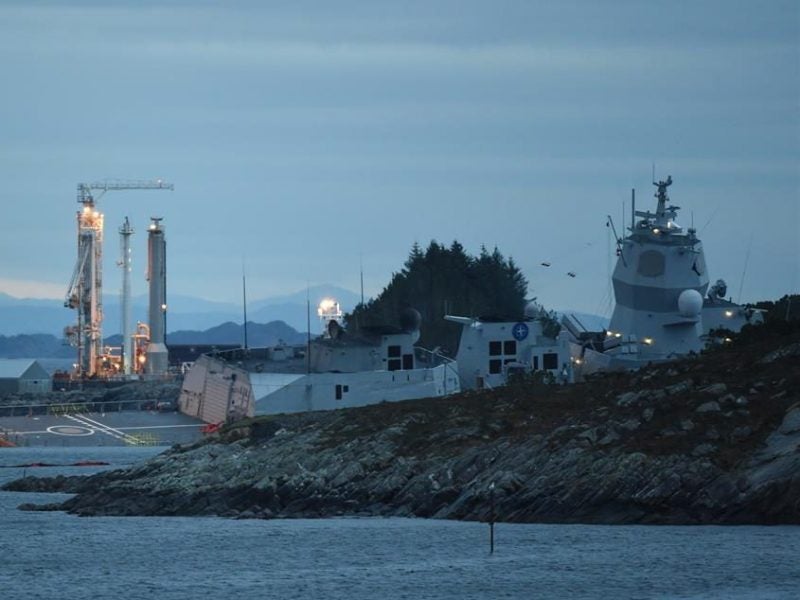
In November 2018, the Royal Norwegian Navy’s HNoMS Helge Ingstad collided with the oil tanker Sola TS on a clear night, where both ships would have been visible by eye and radar. A newly published report on the accident has criticised the lack of experience and communication that led to the collision, and produced a list of safety measures to prevent similar incidents in the future.
The night of the collision
While travelling through the Hjeltefjord area in Norway the Helge Ingstad and its crew of 137 personnel struck the Maltese-registered Sola TS while sailing through the region at around 17 knots. The frigate was navigating with its automatic identification system (AIS) in passive mode, making the ship appear as an ‘unidentified echo’ on radar.

Discover B2B Marketing That Performs
Combine business intelligence and editorial excellence to reach engaged professionals across 36 leading media platforms.
The frigate’s bridge was active with two sailors receiving training and an officer of the watch handover in progress.
The oil tanker, which had set off from the Sture oil terminal at Stura and notified shipping control of its departure, was underway with its deck lights on making its navigation lights “difficult to discern”, according to the report. The report added: “The lights from the tanker appeared to be an extension of the lights from the terminal”. Two officers on-board the frigate reportedly mistook the tanker for a ‘stationary object near the shore’.
As the two ships began to close in on each other, the tanker crew requested more information about the approaching frigate. The frigate’s officer of the watch was convinced of the safety of the voyage, making little use of radar and other navigation systems.
When the oil tanker eventually received notification of the approaching frigate it established contact with the ship, asking it to navigate out of the tanker’s path. Investigators found that the tanker could have been clearer about its location to avoid confusion as the crew of the Helge Ingstad believed another ship to their port side had contacted them, not the tanker. At that point the frigate’s bridge team still believed the tanker was a stationary object.

US Tariffs are shifting - will you react or anticipate?
Don’t let policy changes catch you off guard. Stay proactive with real-time data and expert analysis.
By GlobalDataWhen two vessels were within 500 metres of each other, the tanker crew shut off its engines and made another request for the frigate to change course. Thirty seconds before the collision the officer of the watch realised the assumed stationary object was indeed the moving tanker and attempted to avoid the ship. The collision tore a hole in the side of the $500m frigate, causing it to run aground.
The report concluded: “The crew on HNoMS Helge Ingstad did not realise that they were on collision course until it was too late.”
 HNoMS Helge Ingstad was raised to be salvaged for scrap this year. Credits: Royal Norwegian Navy.
HNoMS Helge Ingstad was raised to be salvaged for scrap this year. Credits: Royal Norwegian Navy.
Lessons learned from Helge Ingstad: safety recommendations
As a result of the collision, the report from Board Norway (AIBN) and the Defence Accident Investigation Board Norway (DAIBN), along with other authorities, issued a list of safety recommendations that came down strongly on the Royal Norwegian Navy for its failings in the lead-up to the costly collision. The report’s suggestions cover everything from training and career paths to the use of systems onboard the vessel.
The report does not just criticise the navy; it also includes several recommendations to the operators of the tanker, the Norwegian Coastal Administration, and the Norwegian defence ministry.
The report states: “The navy lacked competence requirements for instructors and procedures to ensure the functioning of the bridge team while administering training.
“The Accident Investigation Board Norway recommends that the Royal Norwegian Navy establish competence requirements and procedures for training activity on the bridge, attending to both the training function and safe navigation.”
As the bridge team was trying to navigate a relatively busy area while also training crew, the report noted that training hampered their ability to properly monitor traffic. As a result of this, a need to maintain the proper functioning of the bridge while training is underway is clear.
Another recommendation in the report addresses navy sailors’ career paths. “As a consequence of the clearance process, the career ladder for fleet officers in the navy and the shortage of qualified navigators to man the frigates, officers of the watch had been granted clearance sooner, had a lower level of experience and had less time as officer of the watch than used to be the case,” the report states.
This implies that due to a shortage of personnel, officers are being pushed through the process quicker than in the past, resulting in a lack of operational experience. The report recommends the navy undertake measures to ensure “that bridge teams have a sufficient level of competence and experience”.
It also suggests that the navy review its bridge procedures and governance to solve issues of “organisation, leadership and teamwork” that played a role in the Helge Ingstad’s collision. The report explains that current bridge manuals do not provide sufficient information and support for the safe operation of ships. It also calls on the navy to evaluate its use of systems such as AIS to ensure proper visibility of its vessels on radar.
Criticism also focused on the absence of a voyage data recorder on the Helge Ingstad, which hampered efforts to review the events of the collision. The report recommends that the navy should install VDR systems on its vessels.
Further criticism against the navy also calls for better cooperation and a formalisation of procedures with coastal authorities. The report suggest both organisations should “develop and implement guidelines for the use of Warship AIS” to prevent a similar incident happening again.
The full report is available here.





